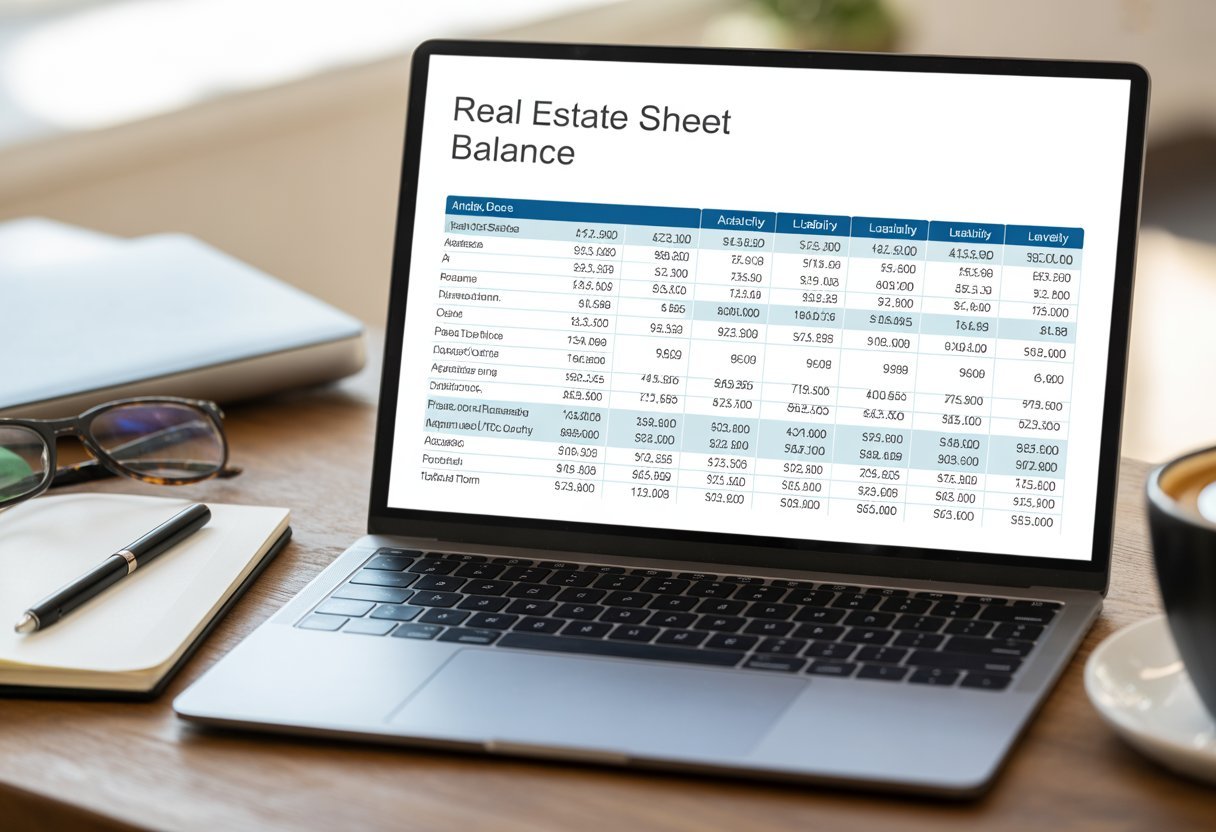Managing rental properties requires a solid grasp of accounting principles and terminology. Your success as a landlord depends on accurately tracking income, expenses, and financial performance using the right accounting methods and terms.
Understanding real estate accounting terminology enables you to make informed decisions about your rental property investments, maintain accurate books, and maximize tax advantages while staying compliant with regulations. The specialized vocabulary used in property management accounting may seem complex at first, but mastering these terms will help you communicate effectively with accountants, tax professionals, and other stakeholders.
As you grow your rental property portfolio, you’ll need to track various financial metrics like accounts payable, operating expenses, and general ledger entries. This comprehensive guide breaks down essential accounting terms you’ll encounter regularly as a landlord.
Key Takeaways
- Proper accounting terminology helps you maintain accurate financial records and communicate with professionals
- Understanding key terms allows you to track property performance and make data-driven decisions
- Mastering accounting concepts like passive activity loss rules helps maximize tax benefits and ensure regulatory compliance
Key Real Estate Accounting Concepts
Real estate accounting involves essential financial tracking and reporting methods specific to property transactions and management. Proper accounting helps maintain accurate records and ensures compliance with tax regulations.
Accounts and Ledgers
Your general ledger serves as the foundation for tracking all financial activities in real estate operations. It contains detailed records of income, expenses, and property-related transactions.
Each property should have separate accounts to track individual performance metrics and cash flows. This separation enables clearer financial analysis and decision-making.
Common account categories include:
- Rental income
- Property maintenance expenses
- Insurance costs
- Property tax payments
- Mortgage payments
Assets and Liabilities
Assets in real estate accounting include properties owned, cash reserves, and expected rental payments. Each property must be recorded at its purchase price plus any improvement costs.
Your liabilities encompass:
- Short-term obligations: Property taxes, insurance premiums
- Long-term debts: Mortgages, construction loans
- Operating expenses: Maintenance costs, utilities
Track depreciation carefully as it affects both asset values and tax calculations. Building values typically depreciate over 27.5 years for residential properties.
Equity and Capital
Your equity represents ownership interest in properties after subtracting liabilities from assets. Initial capital investments and ongoing profits contribute to increasing equity positions.
Real estate businesses must track capital accounts for each investor or partner, showing:
- Initial investments
- Profit distributions
- Capital withdrawals
Maintain detailed records of equity changes through:
- Property appreciation
- Mortgage principal reduction
- Retained earnings from operations
Financial Statements in Real Estate
Real estate financial statements provide crucial insights into property investments and business performance through three essential documents that track assets, income, and cash movement.
Balance Sheet Fundamentals
Your real estate balance sheet displays assets, liabilities, and equity at a specific point in time. The fundamental equation is: Assets = Liabilities + Equity.
Key Components:
- Assets: Properties, cash, accounts receivable
- Liabilities: Mortgages, loans, accounts payable
- Equity: Investment capital, retained earnings
Book value represents the total value of your assets minus accumulated depreciation. This figure helps track the investment’s worth over time.
Important Ratios:
- Current Ratio = Current Assets ÷ Current Liabilities
- Quick Ratio = (Current Assets – Inventory) ÷ Current Liabilities
Working capital equals current assets minus current liabilities, indicating your ability to meet short-term obligations.
Income Statement Overview
Your income statement shows revenue generation and expenses over a specific period, typically quarterly or annually.
Revenue Sources:
- Rental income
- Property management fees
- Capital gains from sales
Gross profit equals total revenue minus direct costs. Net profit or loss is calculated by subtracting operating expenses, taxes, and interest from gross profit.
Track vacancy rates and maintenance costs carefully, as these directly impact your bottom line.
Cash Flow Statement Analysis
The cash flow statement tracks money movement through operating, investing, and financing activities.
Operating Activities:
- Rent collection
- Property maintenance payments
- Insurance and tax payments
Investing Activities:
- Property acquisitions
- Renovation costs
- Equipment purchases
Cash flow analysis helps predict future liquidity needs and evaluate investment performance. Monitor your operating cash flow ratio to assess property management efficiency.
Types of Real Estate Accounts
Real estate accounting requires organizing transactions into distinct categories that reflect your business’s financial position and operational activities. These accounts track your immediate financial resources and obligations alongside long-term property investments and debts.
Current Assets and Liabilities
Your current assets include resources you can convert to cash within one year. Common real estate transactions require tracking rent payments through accounts receivable and maintaining cash reserves for property operations.
Prepaid expenses like insurance and property taxes need separate accounts to track advance payments. Your inventory accounts track supplies and materials for property maintenance.
Current liabilities encompass short-term debts due within 12 months. These include accounts payable for vendor services, accrued expenses for utilities, and property management fees.
Fixed Assets and Long-Term Liabilities
Your fixed assets represent significant property investments that generate income over multiple years. Buildings, land, and major improvements fall into this category. Track depreciation on buildings and improvements to account for wear over time.
Real estate management companies must maintain detailed records of mortgages and loans under long-term liabilities. These accounts track principal balances, interest payments, and loan terms.
Equipment and vehicles used in property management count as fixed assets. Create separate accounts for each major property or building to monitor individual performance.
Revenue and Expenses in Real Estate
Tracking financial flows accurately determines success in real estate investments through proper revenue recognition and expense management strategies.
Recognizing Revenue
Revenue in real estate comes primarily from rental income, property sales, and lease agreements. You must record rental payments when tenants pay their monthly dues.
Property sale revenue requires careful timing – recognize it only when the transaction closes and ownership transfers. Lease income should be amortized over the lease term rather than recorded as a lump sum.
Security deposits don’t count as revenue until you have the right to keep them. Record them as liabilities until that point.
Managing Expenses
Your real estate expenses fall into several key categories that affect your bottom line. Track property maintenance, insurance, property taxes, and utilities separately.
Management fees and advertising costs are essential overhead expenses. You can depreciate major property improvements over their useful life rather than expensing them immediately.
Property-related expenses to track:
- Insurance premiums
- Property taxes
- Maintenance and repairs
- Utilities
- Professional services
- Marketing costs
Allocate shared expenses across multiple properties based on square footage or unit count. Keep detailed records of all financial transactions for accurate reporting.
Valuation and Appraisal Terminology
Real estate valuation encompasses specific methods and techniques used to determine property values. These processes help establish fair market prices, assess investment potential, and support financial decisions.
Appraisal Methods
Professional appraisals involve systematic evaluations of a property’s worth by certified experts.
You’ll encounter three primary appraisal approaches:
- Cost Approach: Calculates property value based on land cost plus building replacement cost minus depreciation
- Income Approach: Determines value through potential rental income and operating expenses
- Sales Comparison: Evaluates similar recently sold properties in the area
The choice of method depends on the property type and intended use of the appraisal.
Market Value and Fair Market Value
Market value represents the most probable price a property would sell for under normal conditions.
Your property’s fair market value considers:
- Willing Buyer/Seller: Both parties acting without pressure
- Reasonable Time: Adequate exposure to the market
- Normal Conditions: Standard financing and market circumstances
Asset Valuation Techniques
Asset valuation methods help you determine a property’s worth through different analytical approaches.
Key techniques include:
- Depreciated Cost: Original cost minus accumulated depreciation
- Capitalization Rate: Net operating income divided by property value
- Comparative Analysis: Direct comparison with similar properties
You should consider factors like:
- Physical condition
- Location quality
- Economic trends
- Market demand
Investment and Performance Metrics

Investment and performance metrics provide essential tools for measuring the financial success of real estate ventures. These key calculations help determine profitability, cash position, and the ability to convert assets into cash.
Return on Investment (ROI)
ROI measures the profitability of your real estate investments by comparing the gain or loss relative to the cost.
To calculate ROI, divide your net profit by the total investment cost and multiply by 100. For example, if you invested $200,000 in a property and made $20,000 in profit, your ROI would be 10%.
Consider both cash and non-cash returns when calculating ROI. Cash returns include rental income and proceeds from sale, while non-cash returns encompass appreciation and tax benefits.
After-Tax Cash Flow
After-tax cash flow represents the actual money you keep after accounting for all expenses and tax implications.
Key components of after-tax cash flow:
- Rental income
- Operating expenses
- Mortgage payments
- Property taxes
- Tax deductions and depreciation benefits
Your after-tax position significantly impacts the true profitability of your investment property. Tax benefits like depreciation deductions can substantially improve your net returns.
Liquidity Concepts
Liquidity measures your ability to convert real estate assets into cash without significant loss of value.
Real estate typically offers lower liquidity compared to securities or stocks. You can improve liquidity through:
- Maintaining cash reserves
- Securing lines of credit
- Choosing properties in high-demand areas
- Structuring flexible lease terms
Consider establishing multiple exit strategies to enhance your liquidity position. Quick-sale options might include offering seller financing or working with cash buyers.
Regulatory and Industry-Specific Terms

The real estate industry operates under specific regulatory frameworks and accounting standards that govern how transactions and entities are structured and reported.
Real Estate Entities and Agreements
Real estate business structures commonly include LLCs and S Corporations, each offering distinct tax and liability advantages. An LLC protects your personal assets while providing operational flexibility and pass-through taxation.
S Corporations offer similar benefits but have stricter ownership requirements and corporate formalities. Your choice between these entities impacts tax reporting and compliance obligations.
Common agreements include purchase contracts, lease agreements, and property management contracts. These documents require specific accounting treatments to properly record revenue, expenses, and asset values.
Accounting Standards and Compliance
Your real estate transactions must follow standardized accounting principles under GAAP or IFRS frameworks. IFRS standards affect how you report investment properties and recognize lease income.
Key compliance areas include:
- Revenue recognition for rental income
- Capitalization of property improvements
- Depreciation methods for real estate assets
- Fair value measurements of properties
You need to maintain detailed documentation for property valuations, impairment assessments, and related party transactions to meet regulatory requirements.
Additional Real Estate Accounting Terms

Real estate transactions involve specific accounting terminology across various documentation, tax considerations, and international dealings that impact your financial records and legal obligations.
Abstracts and Title Terms
An abstract of title is a chronological history of your property’s ownership and legal matters. You need this document to verify clean property ownership.
Adverse possession affects your property rights when someone occupies your land without permission for a legally specified period. You must document these claims in your accounting records.
Key Title Terms:
- Adjacent: Properties sharing a common boundary
- Adjoining: Properties that touch at any point
- As-is: Property sold in current condition without warranties
Taxes and Deductions
Ad valorem taxes are based on your property’s assessed value. You calculate these annually as a percentage of the total value.
Common Tax Deductions:
- Property tax payments
- Mortgage interest
- Depreciation expenses
- Maintenance costs
Tax abatement programs can reduce your property tax burden for a specified period. You must track these reductions separately in your books.
Legal Clauses and Addenda
An acceleration clause requires immediate full payment of your loan balance under specific conditions. Your accounting system needs to flag these potential obligations.
Important Documents:
- Addendum: Written changes to original contracts
- Amendment: Formal modifications to existing agreements
- Agency agreements: Define agent relationships and fees
Track each document modification with unique reference numbers in your ledger.
Foreign Currency Considerations
Your functional currency is the primary currency used in your business operations. Record all transactions initially in this currency.
Converting foreign currency transactions:
- Use exchange rates from transaction dates
- Document exchange rate sources
- Track currency gains/losses separately
Credit and debit entries involving multiple currencies require careful documentation of conversion rates and dates.
Frequently Asked Questions

Real estate accounting requires precise handling of expenses, income tracking, and tax implications to maintain accurate financial records and comply with regulations.
What distinguishes capital improvements from regular maintenance expenses?
Capital improvements add value to a property and extend its useful life, like adding a new roof or remodeling a kitchen. These costs must be capitalized and depreciated.
Regular maintenance expenses keep the property in working condition, such as fixing a leaky faucet or painting walls. These costs are deducted immediately as operating expenses.
How is real property depreciation calculated in real estate accounting?
Residential rental properties depreciate over 27.5 years using the straight-line method. Commercial properties depreciate over 39 years.
Your annual depreciation equals the property’s basis (purchase price plus improvements) divided by the depreciation period. Land value is excluded from depreciation calculations.
Can you explain the difference between cash and accrual accounting in real estate?
Cash accounting records transactions when money changes hands. You record rent when tenants pay, not when it’s due.
Accrual accounting records transactions when earned or incurred. You record rent income on the first of the month, regardless of when tenants pay.
What are the implications of 1031 exchanges for real estate tax accounting?
A 1031 exchange lets you defer capital gains taxes by exchanging one investment property for another of equal or greater value.
You must identify replacement properties within 45 days and complete the exchange within 180 days. The basis of your old property transfers to the new property.
Could you detail the process of recording a mortgage in real estate accounting?
Record the mortgage principal as a liability on your balance sheet. The monthly payment splits between principal reduction and interest expense.
Track escrow accounts separately for property taxes and insurance. Record mortgage fees and closing costs according to their specific nature.
How is operating income calculated for a real estate property?
Operating income equals total rental revenue minus operating expenses. Operating expenses include maintenance, utilities, insurance, and property management.
Exclude mortgage interest, depreciation, and capital expenditures from operating expense calculations.



